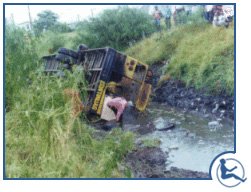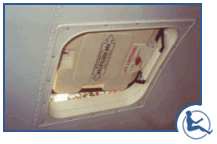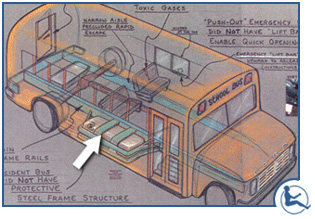SCHOOL BUS HAZARDS
School buses need safer fuel tanks, the use of non-flammable materials for the seats, fire extinguishers, and emergency escape windows and roof hatches to enable rapid escape and rescue in the event of a fire. While newer buses have added some of these features, many are still on the road that need to be upgraded and retrofit.
 The Maquiladora school bus accident is a compelling case in point. Fourteen young adult Mexican workers burned to death in June 1997, when the bus veered off the road, rolled over onto its right side in a shallow drainage ditch, and quickly caught on fire. Twelve workers were able to quickly escape through the rear exit door, but fourteen others perished when they were overcome by the dense toxic smoke from the fire that rapidly engulfed the bus... and there were no roof escape hatches or emergency windows to facilitate their exit or rescue. The Maquiladora school bus accident is a compelling case in point. Fourteen young adult Mexican workers burned to death in June 1997, when the bus veered off the road, rolled over onto its right side in a shallow drainage ditch, and quickly caught on fire. Twelve workers were able to quickly escape through the rear exit door, but fourteen others perished when they were overcome by the dense toxic smoke from the fire that rapidly engulfed the bus... and there were no roof escape hatches or emergency windows to facilitate their exit or rescue.
 In the Texas trial in 1999, vehicle safety expert Byron Bloch testified that the bus was defective because it had highly flammable seat materials, no roof escape hatches, nor any emergency exit windows, an aisle that was much too narrow, an exposed battery located within the bus interior, and no fire extinguisher. In the Texas trial in 1999, vehicle safety expert Byron Bloch testified that the bus was defective because it had highly flammable seat materials, no roof escape hatches, nor any emergency exit windows, an aisle that was much too narrow, an exposed battery located within the bus interior, and no fire extinguisher.
In his testimony, Bloch used videos and exemplar parts to show how rapidly a school bus fire spreads, how the emergency escape windows and roof hatch function, and how they could easily have been retrofit. He presented evidence from a U.S. Congressional Hearing in the early 1970's that pointed out the feasibility of school bus safety features. The defendant company presented no defense, and settled during trial for $30-Million.
In the 1988 Kentucky school bus accident , a small Toyota pickup driven by a drunk driver crashed head-on into a 1977 Ford-Superior school bus. The fuel tank was punctured, and an immediate fuel-fed fire quickly engulfed the school bus. There was no protective cage around the fuel tank, which Ford had withheld from installing because this bus was built eight days before a federal requirement took effect. The school bus also had highly-flammable seat materials, a very narrow aisle, and no emergency escape windows, with only a single emergency exit door located at the rear of the bus.

Twenty-four children and three adults became needlessly entrapped and tragically perished in the fuel-fed fire. Mr. Bloch consulted on this Kentucky school bus case and personally inspected the school bus fuel tank and fire-gutted interior, and provided key documents from his Auto Safety Archives. The case settled during the trial. This Kentucky accident had the highest death toll in any school bus accident in our Nation's history.
|